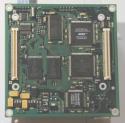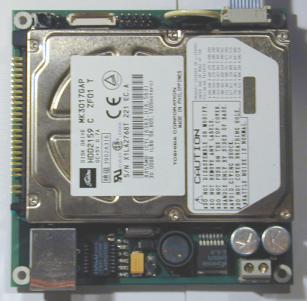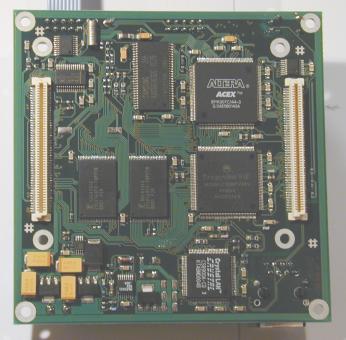Meet Dragonix, an ‘open hardware’ Linux SBC
May 28, 2002 — by LinuxDevices Staff — from the LinuxDevices Archive — 34 views
What's Dragonix? It's an “Open Hardware” single-board computer (SBC), based on a Motorola Dragonball 68VZ328 processor, running uClinux.
Where did the Dragonix come from? During his graduate thesis work, Daniel Haensse had used a Lineo uCsimm SBC running uClinux to measure brain oxygenation changes in neonates. Haensse enjoyed the uCsimm/uClinux hardware/software experience so much, that he subsequently decided to design and manufacture his own uClinux-powered SBC. Haensse was later joined by “kitkat”, who has done most of the Dragonix's uClinux software development. Together, the two-man team has now completed the basic project and is in the process of designing a family of Dragonix add-on boards which target specific applications such as a firewall, MP3 player, or home automation.
Why an “Open Hardware” project? “I released the Dragonix design as 'open hardware' in the hopes that it would be useful to other people who want to build custom designs of their own,” explained Haensse. The Dragonix PC board layout design is available free for “personal use” — but must be licensed (for a fee) by anyone who wants to incorporate it into a commercial product. The Dragonix project also encourages engineers to use their designs as the basis of prototypes for exploring technologies or evaluating design feasibility, as part of commercial projects, and considers such use to fall within the intention of the “personal use” license.
Dragonix specs
The Dragonix SBC is a compact (100 x 100 mm) and highly integrated SBC that includes the following onboard functions . . .
- Motorola Dragonball 68VZ328 processor; 33MHz CPU clock
- 32MB of SDRAM memory
- 2 x 2MB of onboard Flash (individually write-protectable)
- 10Base-T Ethernet controller with onboard status LEDs
- One RS232C serial port with TXD, RXD, CTS, RTS, DSR, DTR and RI/CD signals
- Second serial port with CMOS levels, IrDA compatible
- Two SPI interfaces
- LCD controller for mono and color displays (up to 640×512 pixels)
- Display touch panel controller (12 bit ADC, may be used as general purpose ADC)
- Altera ACEX 1k30-3 FPGA with 50 free pins (one PLL input) and JTAG
- Address, data, and other important signals broad out on two 100 pin connectors
- Operates from 9-30V DC (onboard step-down converter with 5V, 3.3V, and 2.5V provided externally
- Onboard watchdog and reset controller
- Real time clock with battery backup and 96 bytes of SRAM
- Mounting holes for 2.5-inch IDE hard drive
- Size: 100 x 100 mm

Dragonix top side, with hard drive installed

Dragonix bottom side, showing ICs
Dragonix add-on boards
Several Dragonix expansion boards are also under development . . .
- Prototype add-on board — a simple add-on board providing easy access to all the signals from the two high density connectors, as well as JTAG and display interface connectors. It is intended for prototypes that should have been “finished yesterday”.
- Personal firewall / MP3 player add-on board — a complex 150 x 150 mm board that includes an interface connector for color and mono LCDs, a second Ethernet controller, four USB (host) ports, a second RS232C port, two RS485 ports, IRDA, TV infrared driver, MP3 decoder, and IDE hard drive (or CompactFlash) interface. This photo shows the add-on board with the Dragonix installed on it.
- Modbus node add-on board — this board will act as a modbus node. Multiple nodes can be connected to the personal firewall add-on board and controlled through the GUI on its display. Inputs will be used to measure local humidity and temperature; power switches will control a light, humidifier, etc.; and a motor controller and driver will be used for controlling roller blinds. This board can be used to implement a simple home automation node.
- 2nd RS232C and IEEE 1284 add-on board — this 100 x 160 mm board includes a 2nd RS232C port plus an IEEE-1284 parallel port. See photo.
- GSM/GPRS, DECT, Bluetooth, and 12 channel driver add-on board — this universal wireless communication board includes an onboard Siemens MC35 GSM module, but may also be used to interface with a DECT or Bluetooth set. Combined with the Ethernet controller on the Dragonix mainboard, it is possible to use the two board set as a Gateway.
According to Haensse, the Dragonix boards are “fully functional, but I would like to get the FPGA stuff (VHDL-Code) into better shape and documented. Currently we are working to get jffs (journaling flash filesystem) working on the Dragonix, which will be finished with the next couple of weeks.”
A small quantity of Dragonix boards is available for immediate sale, at what Haensse says is roughly their cost: 600Euro for a complete “developer kit”. The kit includes the assembled and tested Dragonix SBC plus a monochrome PDA-type LCD display (see photo of Dragonix and LCD) and the SBC's uClinux distribution on CD-ROM. Design documentation is available for download from the Dragonix website.
“'kitkat' is working hard to finalize his 'Vienna++' embedded GUI-framework, to get the GUI ready for public use,” Haensse added. “It's implemented in C++ and optimized for small embedded systems with limited memory and performance resources.”
“We need more help to take the next steps with our 'Dragonix Project',” said Haensse. “We hope to increase our team and maybe we can get the same [community effort] on the hardware side that we have seen on the software side with Linux!”
Haensse and 'kitkat' plan to offer various professional services, including custom add-on board designs, hardware/software application development, and other consulting services.
This article was originally published on LinuxDevices.com and has been donated to the open source community by QuinStreet Inc. Please visit LinuxToday.com for up-to-date news and articles about Linux and open source.